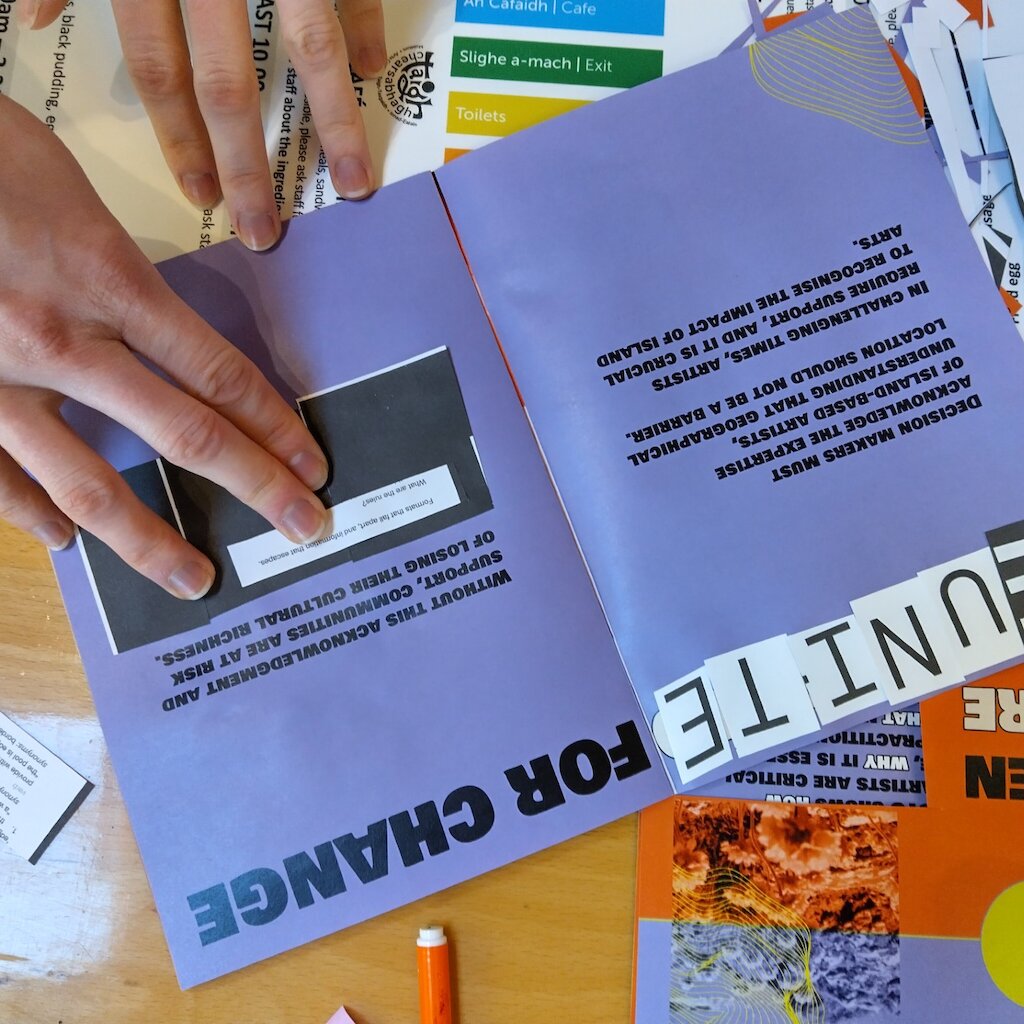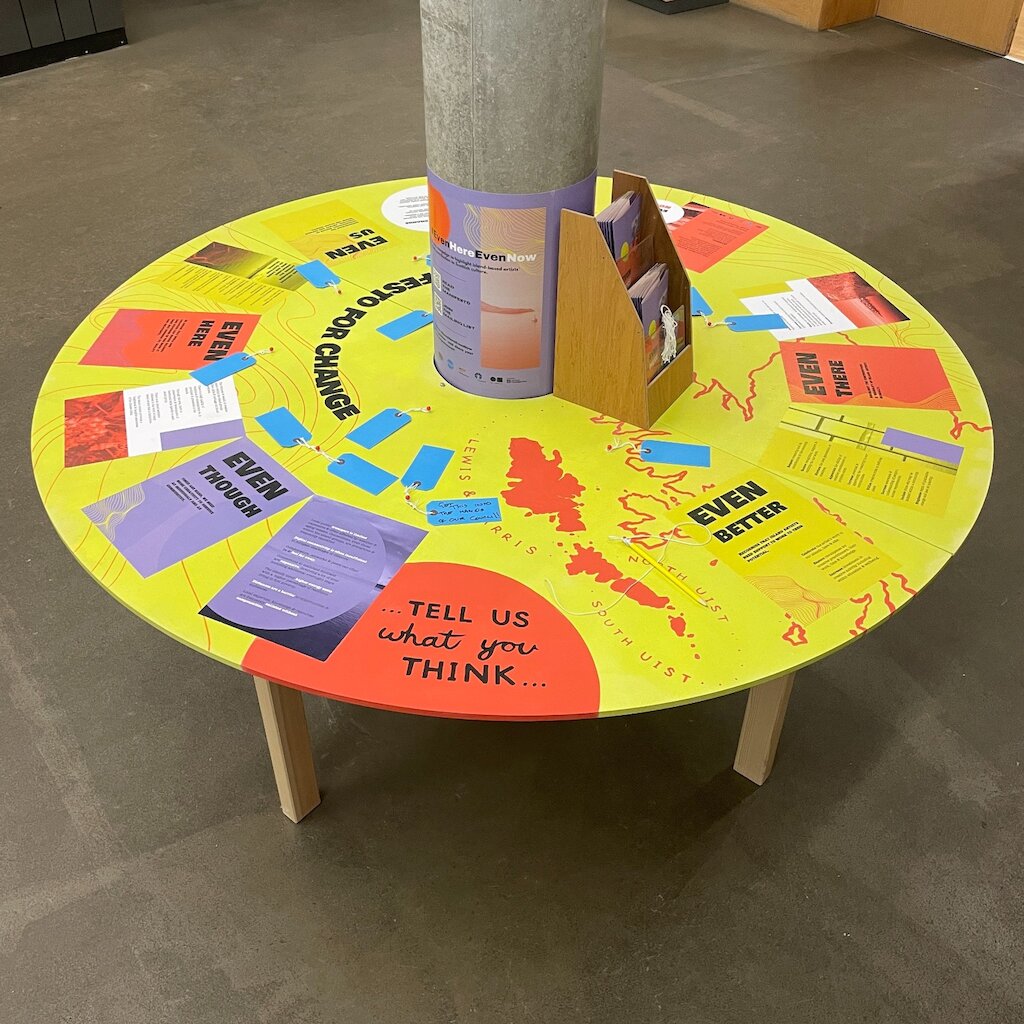Can you tell us a bit about your VACMA funded project? Including what has inspired you, how it develops your practice and what you are exploring.
The VACMA provided funds to aquire specialist Washi papers like 12gsm Gampi and a new piece of equipment to support my ongoing studio practice around exploring the artist multiple. A Hot Foil press, combined with Letterpress Type has enabled me to use new materials in my work, and emboss text onto bookboard, leather, and plywood. The papers have also started to become incorporated in my developing Woodcuts. These experiements feed into my continued interest in the artist book format as a vehicle for exploring space between text and image.
Several experiments from this period organically developed into a new fold-out publication, Instructions for Time Travel with West Burra Quartz. I produced this work as an artist multiple of 18 copies + 1 artist proof for London-based SWAP Editions and contributed other sketches + works-in-progress for a virtual landscape of interconnecting ‘Artist Islands’ which ran through SKELF virtual project space.
Since moving to West Burra, I’ve found myself pulled towards special spots in the landscape, where prominent veins of quartz run through the black rock like rips in the fabric of time. Instructions for Time Travel with West Burra Quartz began life a short text I wrote whilst thinking about two specific pieces of quartz I’ve owned since age 6. There has been many times throughout the years where I’ve been exploring dark spaces (my primary school stationary cupboard or 50 metres down the bottom of an ancient ochre mine in the Mendips) and found myself rubbing the quartz pieces together to activate their triboluminescent glow. A beacon in some moment of dark. The accumulation of these memories are like a window back through time for me, and through this work I was thinking about how to create a similar window to move forward in time. Past any difficulties, into a future. Making multiple copies of this work to disperse across the world made particular sense. Who wouldn’t want a way to travel back or forward in time?
Do you listen to any music when you're creating, or in quiet periods? If so, what's in your playlist? If not music, what helps to inspire your work?
Sound is a very important part of my life. Listening is often it is the starting point or a way in to a period of making. As far back as I can remember, I’ve gone out in the world to make sound recordings. Listening is a really grounding process when feeling lost (often before a work emerges). I use tape recorders, smart phones, and special audio recorders – whatever is to hand, oftening focusing in on a tiny detail that I hadn’t noticed before (often listening to it on loop). By now I have libraries of field recordings on tape, and digital files, and this is a good place to start something new.
Sound comes into other strategies I use in my work. If I am trying to write I can listen to a piece of work such as Superfluous noise sweep (2015) which was my contribution toward Aren't: Alternative Audio Guide for the National Gallery (London). The piece is a looping wave of noise, along similar frequencies of human speech. Listening to it sort of wraps you in a noise blanket which blocks out external world and lets you concentrate on going inward.
Other music I enjoy at the moment is:
What role do you think the arts and creativity can play in society, especially at time like this?
If you take a moment to really consider it, I’m sure most people would agree that the Arts and Creativity play key roles in keeping us sane in these very difficult times. Whilst not everyone will channel their boredom/frustration/anxiety/hope into making an actual ‘Work of Art’ – creativity in the broadest sense, provides us with some of the best strategies for coping in difficult periods. Whether it’s doing some drawing, a bit of gardening, woodwork or DIY – from recent experience I know that even making a meal using up what’s left in the cupboard requires creative thought processes. And even if you are really not feeling up to doing much at all, I would bet the creative industries filter into atleast several aspects of your days enjoyment and/or escapism: Radio, Podcasts, Books, Blogs, Netflix, Youtube, Gaming etc – none of this would exist without the Creative Industries. Many Art Colleges around the world today even teach new intergrated subjects like Healthcare Design or Service Design. Graduates from these programmes use their creative education to improve our Hospitals or Care infrastructure. It was recently summed up to me as follows: “often the arts is considered the icing on the cake, when actually without it there would be no cake!”.
Daniel Clark (b. 1988, Banbury) is an artist + co-director of Gaada, a visual art workshop + artist-led organisation based in Burra, Shetland.
Clark is a graduate and former staff member of the Royal College of Art. His work is part of collections such as the Victoria and Albert Museum, Bishopsgate Institute, and The British Library Sound & Moving Image Archive.
www.danielclark.xyz
www.gaada.org











